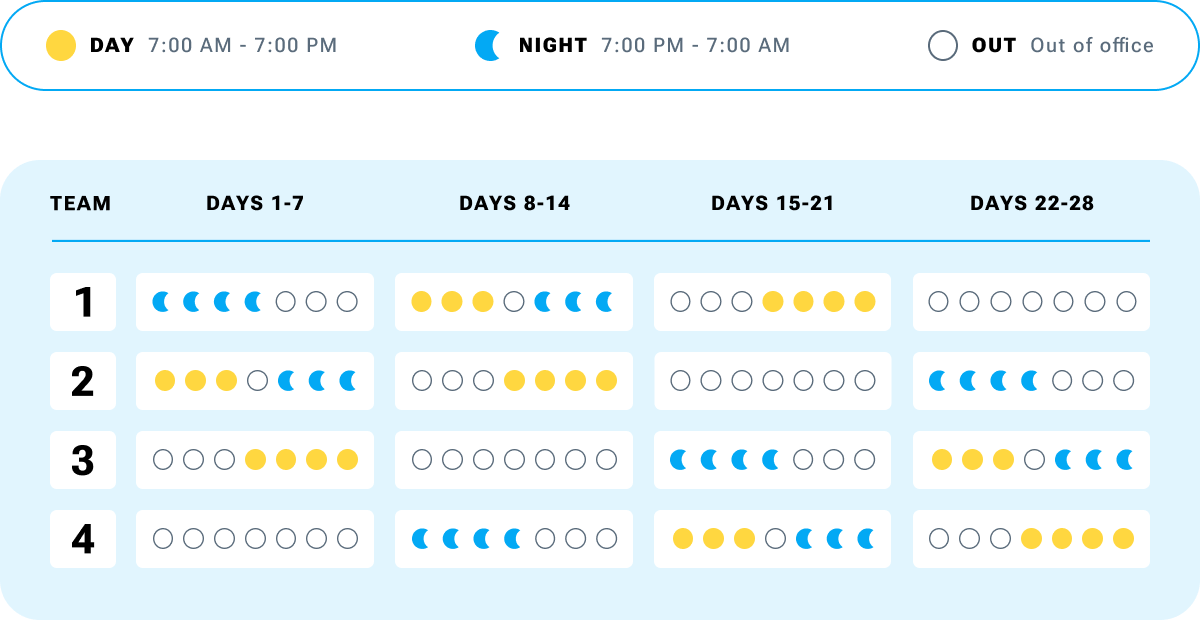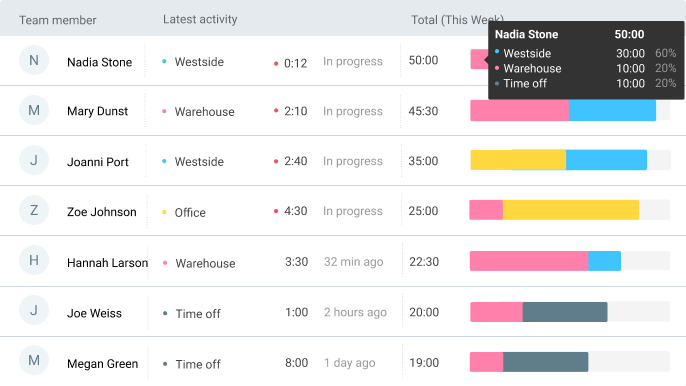If your business is rapidly expanding, and the number of your customers keeps growing — sooner or later you may also start thinking about changing your work time and staying open 24/7.
But, what schedule should you use in that case? One of the work patterns that you’ll find practical is the DuPont work schedule.
If you continue reading our blog post you will find out:
- The characteristics of the DuPont work schedule,
- What industries use the DuPont work schedule,
- The pros and cons of the DuPont Schedule, and
- Practical tips on how to implement the DuPont work pattern.

Table of Contents
What is the DuPont work schedule, and how does it work?
If your company needs 24/7 coverage with enough time off for your employees, then the DuPont schedule is the right solution for you.
The name DuPont comes from an American multinational chemical company that invented this work schedule, and used it first in the 1950s. This company was established by French-American chemist Éleuthère Irénée du Pont de Nemours in 1802.
The DuPont work schedule is a type of 24/7 work pattern which consists of:
- Four week cycles,
- Four teams, and
- Two 12-hour work shifts (both day and night).
This is how the DuPont workweek functions — the four-week cycle is divided into 4 weeks, and each week has a different schedule:
Week #1: 4 night shifts followed by 3 days off.
Week #2: 3 day shifts, 1 day off, then work 3 night shifts.
Week #3: 3 days off, then 4 day shifts.
Week #4: 7 consecutive days off.
Even though there are 4 teams, not all of them start from week#1.
For example, team #1 will start from week#1, team #2 will start from week #2, and so on. Furthermore, the cycle usually starts on Monday, but it can start on any other day of the week.
To understand the DuPont workweek better, look at the table below:

As you can see from the table, 4 teams follow the four-week cycle:
- Team #1 starts its cycle from week #1 — they work 4 night shifts and then have 3 days off,
- Team #2 starts from week #2 — they work 3 day shifts, have 1 day off, then work 3 night shifts,
- Team #3 starts from week #3 — they have 3 days off, then work 4 day shifts, and
- Team #4 starts from week #4 — they have 7 consecutive days off the first week.
After the four-week cycle, the team repeats the whole workweek over again.
Bear in mind that all shifts in the DuPont work schedule are 12 hours long, so employees work for a total of 168 hours per one 4-week cycle.
What industries use the DuPont shift schedule?
Since it helps companies operate 24/7, the DuPont shift pattern is a popular choice among businesses such as:
- Police force,
- Manufacturing companies,
- Power supply companies,
- Gas stations,
- Hospitals,
- Engineering industry, and
- Chemical processing plants.
Now that we’ve seen the basics of the DuPont schedule and the industries that use such work pattern, let’s move on to the advantages and disadvantages of this schedule.
Advantages of the DuPont work schedule
There are a lot of benefits that come with implementing the DuPont work schedule. We have listed some of the most important advantages you will get if you opt for this schedule.
Advantage #1: Your business stays open 24/7
One of the main reasons many companies choose to implement the DuPont schedule is that it allows them to stay open 24/7.
According to research, staying open 24/7 increases customer satisfaction, and it is becoming a new norm due to modern technology. Being available at any time, your business can attract and serve more customers.
Also, if you add the possibility of doing business online, your customer pool is widened as you can attract customers from different countries and time zones. In fact, studies show that this year, worldwide e-commerce will surpass $5 trillion. Consequently, having more customers means greater income.
Advantage #2: Greater customer satisfaction and loyalty
Today, people want to be able to get services or buy products whenever they want because it is more convenient for them.
Thanks to modern technology, even customers from different countries and timezones are now able to purchase your services and products. By staying open 24/7, you will establish customer trust and satisfaction in the long run, as you will always have someone to serve them at all times of the day.
Advantage #3: Employees have a seven-day vacation every four weeks
One of the main benefits that employees get with following the DuPont work schedule is having a seven-day vacation every month. Employees love this advantage as it gives them the opportunity to socialize, travel more, and have more family time.
Advantage #4: Night shifts are evenly distributed among the teams
Creating a schedule with day and night shifts can be tricky, and mistakes are likely to happen. Sometimes, managers will accidentally assign too many night shifts to one team. This can cause dissatisfaction among your team members and even result in burnout.
This is where the DuPont schedule comes in handy.
The DuPont shift schedule automatically ensures that night shifts are evenly distributed among teams. For example, team #1 works night shifts in the first and second week, while team #2 works at night during the first and fourth week.
Furthermore, you can make the process of preparing such a schedule even easier by using schedule templates.
Disadvantages of the DuPont work schedule
On the other hand, there are certain disadvantages that come with using the DuPont work schedule. Let’s see some of the most common ones.
Disadvantage #1: Shift coverage can be challenging
According to the DuPont schedule, employees work 12-hour long shifts and then have several days off to recuperate. The DuPont is a fixed schedule with a fixed number of workers, and if some of the workers get sick or are absent for some reason, it can be challenging to find a cover for them.
For example, it would be impossible for a police officer who has worked for three consecutive night shifts to cover a coworker’s day shift the following day.
That’s why the organization must run like clockwork when following the DuPont schedule.
Disadvantage #2: Each cycle includes a 72-hour long working week
Even though employees are rewarded with one week off every month, they have one long 72-hour working week.
For example, if you look at the table you can see that team #1 has a 72-hour long working week, the second week of the cycle. Thus, they only have one day off in the second week. This can be exhausting for workers, especially if they do a physically challenging job in manufacturing companies, power plants, and similar.
💡 Clockify Pro Tip
Sometimes even employees who don’t work in shifts stay longer at work. Although working long hours is not recommended, here are some tips on how to cope with it:
Disadvantage #3: The DuPont work schedule is not applicable to every industry
The DuPont schedule may not be the best work pattern for every job position or industry. That’s because some positions require employees to work during specific times of day, while they are not needed during other times.
Furthermore, 12-hour shifts are not recommended for jobs that are physically demanding or require spending hours outdoors in the cold or rain, as it can be too exhausting for employees.
Practical tips on implementing the DuPont shift schedule
Implementing the DuPont shift pattern can be tricky as it is a complex process, so here are some tips on how to use it and make the most of it.
Tip #1: Improve your organizational skills
The DuPont schedule involves 4 teams with different 12-hour shifts, and, at first, it seems a bit complicated to create and manage this type of work pattern. But, with good organization, everything becomes easy.
First of all, you should prepare your DuPont work schedule at least a month in advance so that employees are aware of their schedules ahead of time. If you let them know only a couple of days before the start of their workweek, you will get dissatisfied, unproductive, and unhappy staff. By preparing everything and letting them know in advance, your employees will start their shifts refreshed and ready to strive.
Moreover, having time tracking and scheduling in one place simplifies the organization. You should take advantage of modern technology as there are many types of employee scheduling software which are designed to simplify schedule making. This will help you have all information in one place, thus making your job and organization a lot easier.
💡 Clockify Pro Tip
One of the benefits of time tracking is that it helps you organize your schedules. Apart from this, there are many other advantages of time tracking, listed in the following article:
Tip #2: Make the schedule easy to access by using apps
Your employees need to have easy access to their schedules.
Another advantage of using apps and project scheduling software is that they are easy to handle and available to all your employees at any time. Thus, employees are informed about all changes and can check their schedules whenever they want.
When using project scheduling tools, it is much easier to communicate all the changes in the schedule to your employees than to have multiple calls or endless messages. You keep everything transparent, and all employees are on the same page using the same tool.
Another great option that comes with an app such as Clockify is a time clock kiosk for employees. It enables employees to track:
- Their time,
- Breaks, and
- Attendance.
You can make the time clock kiosk available through a phone or a tablet at the entrance of a building, where employees can easily clock in and out.

Then, you can see the latest activities for each employee, such as when they clocked in, and what they are working on at the moment.

Tip #3: Consider the size and skills of your staff
Creating an effective DuPont schedule depends on a variety of factors.
One of those factors is the number of your employees. If you want to stay open 24/7, your company will require 4 teams for 12-hour shifts. You have to make sure you have enough workers, and you also have to think about backups in case somebody gets ill and they need a replacement.
Furthermore, besides determining the number of employees needed, you also have to get to know your workers:
- Their skills,
- Strengths, and
- Weaknesses.
If you give the busiest shift to a new employee, it could reflect badly on the company’s profits and reputation.
On the other hand, you can’t have your most skillful employees working all the time. But, with strategic planning and scheduling staff according to their skills and experience, you can have a strong team of employees successfully covering every shift.
Therefore, as a manager, you should get to know your employees better — their skills, personality types, and levels of proficiency to be able to create effective teams.
Tip #4: Create an effective communication system
If you want to successfully apply the DuPont schedule, your teams must have an effective system for communication.
Your teams will be the most productive if they have a quick and straightforward way of communication. For example, if you have a company with a large number of employees, you will benefit from a team chat app such as Pumble which will enable your employees to quickly stay up to date with the latest news.
Also, if you’d like to have Clockify and Pumble, together with a dedicated project management app, you can get them at a special bundle price.
💡 Clockify Pro Tip
Since the business world is changing quickly, new work schedules are appearing. If you want to find out more about similar alternative schedules, read our blog posts:
Conclusion: Adapt to the fast-growing business environment using the DuPont schedule
With the fast-growing business world and an ever-increasing number of clients, the DuPont shift schedule will help you adapt and take the most out of the 24/7 work pattern. In this blog post, we presented the advantages of this schedule which include customer and employee satisfaction, and disadvantages such as challenges in finding coverage and difficulties in adapting to the long working hours.
We also listed some of the most useful tips on how to implement the DuPont work pattern and how to get the most out of it. Some of the ways to do so are great organization, communicating effectively with your teams, and taking into account the size and skills of your employees.
We hope you found enough information about the DuPont work schedule in this blog post, and that you’ll be able to implement it into your business successfully.



